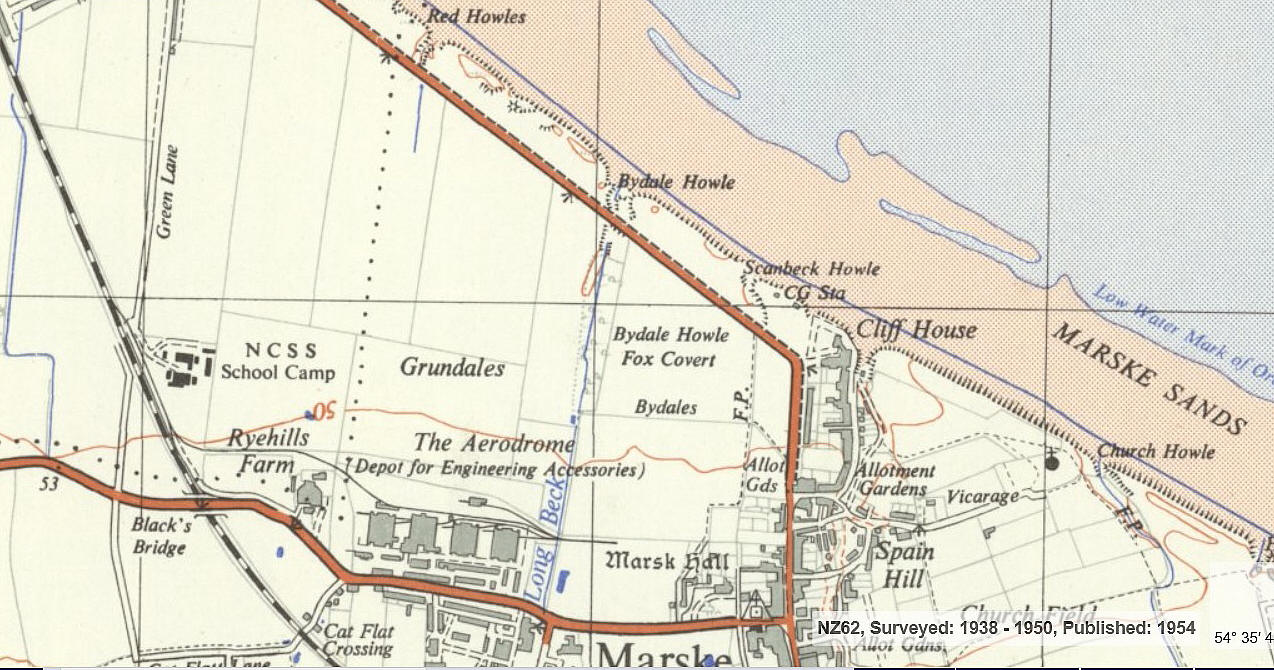Marske flying sites
Note: When I first made this listing several years ago, I made the following comment: "This map only gives my estimation of possibly where the WW1 aerodrome was situated. If anybody could be kind enough to offer a more exact location, this will be most welcome."
In October 2018 I was kindly contacted by David Hinson who provided a map of the WW1 airfield site. My estimation was way out and the map has now been amended.
Note: The aerial view (2018) was obtained from Google Earth ©
MARSKE: Military aerodrome
(Also known as MARSKE-by-SEA)
Military user: RFC/RAF (Royal Flying Corps / Royal Air Force)
No.4 (Auxiliary) School of Aerial Gunnery (Bristol F2B Fighter, Royal Aircraft Factory SE.5a & Sopwith types)
Later: No.2 School of Aerial Fighting
Note: David Hinson also sent me a list he had found of the aircraft types operated by No.2 School, and these were:
Airco DH4 B5224, B5228 & B7878
(Three examples)
Airco DH9 B9341, C1161, C1182, C1183, C1184, C1185, C1273, C1274,
D493, D1261, D7309 & E610
(Twelve examples)
Airco DH9A E9702 & F952
(Two examples)
Avro 504A/504J & 504K B8617, B8700, C694, D4391, D6221, D6276, D6279, D6281,
D7676, D7742, D7745, F8729, F8731 & F8732
(Fourteen examples)
Bristol M1C C4954, C4995, C4996, C4998, C4999, C5000, C5001, C5002,
C5003, C5005, C5006 & C5025
(Twelve examples)
Bristol F2B Fighter B1127, B1321, B8938, C752, C756, C822, C1009, C4675, C4692,
C4694, C4695, C4800, E2550, E2631, F4286, F4315, F4326,
F4522 & F4657
(Nineteen examples)
Martinsyde F4 H7636, H7637 & H7639
(Three examples)
Royal Aircraft Factory RE8 B6619
(One example)
Royal Aircraft Factory SE5a D397, D398, D399, D3943, D3952, E5837, E5844, E5930, F7965
& F8991
(Ten examples)
SPAD S.VII A8802
(One example)
Sopwith Pup B6008, C271 & C414
(Three examples)
Sopwith Triplane N5912
(One example)
Sopwith F1 Camel B2504, B5554, B5582, B7295, B7333, B7447, B7449, B7451, C82,
C84, C87, C167, C175, C176, C177, C178, C179, C180, C190,
C1662, D1880, D1881, D1882, D1932, D1933, D1934, D1936,
D1937, D8225, D8227, E1401, E1455, E1456, E1532, E7295,
F2094, H2712, H2717, H2720 & H2730
(Forty examples)
Sopwith Cuckoo N6952
(One example)
Sopwith Dolphin C3765, C3854, C8090, D3765 & D3773
(Four examples)
Sopwith Snipe E6140, E6142, E6258, E8077, E8114, E8189 & E8316
(Seven examples)
Location: Just NW of Marske-by-the-Sea, about 3nm WNW of Saltburn-by-the Sea
Period of operation: WW1: 1917 to 1919
Site size: 914 x 823
NOTES: When set up in 1917 the site was equipped with seventeen canvas Bessonneau hangars, situated on the western sde of the airfield. Four permanent hangars (1917 type GS sheds) were on the southern boundary. Air to ground targets were set up on the cliff tops.
The No.2 FS (Fightng School) course was for two weeks and served as a 'finishing school' for aircrew before being posted to operational units. It is claimed that, due to the weather, many aircrew never actually flew whilst on this course!
As an aside it appears that Captain W.E. Johns, author of the 'Biggles' books, was a trainee here before being posted to 55 Squadron.
MORE NOTES: One source reckons this site was used for flying since 1910 but see MARSKE SANDS listed below. It would seem 99% certain the WW1 flying activity took place nearby but not from the beach as such.
ANOTHER ASPECT
There is other evidence that a ‘known’ flying site at MARSKE was in temporary use even in 1912. To quote from ‘Old Flying Days’ by C C Turner, “On Christmas Eve, 1912, he (Edward Petre – my note), started off from BROOKLANDS (my capitals) at about 9 a.m. to fly to Edinburgh, a big flight, especially for a pilot of comparatively little experience. The weather had been very unsettled, and there were signs of a gale. Just after noon the gale commenced, and it struck Petre in the afternoon near the coast of Yorkshire. To avoid being blown out to sea he was compelled to land “down wind” at MARSKE. No monoplane of that date would withstand such treatment, and it broke up. Petre was killed, and aviation lost one of its pioneers.”
MARSKE SANDS: Early aircraft proving site
Note: These first two pictures from Mrs P Blackburn have been scanned from the most excellent book, British Aviation - The Pioneer Years, by Harald Penrose first published in 1967. The third and fourth pictures were taken by the author in August 2018 and appears to illustrate that the nature of the beach as being suitable for flying experiments has changed considerably in the last hundred years.
Location: On the beach between Marske and Saltburn
NOTES: It does seem that MARSKE SANDS was the first test flying site, (in early 1910?), for Robert Blackburn’s first monoplane. It was a flop. It did indeed take-off and flew quite well it apears, until he attempted to turn. Then he crashed.
In those days many early aviators were well pleased to accomplish 'straights', of ever increasing length, but the main problem initially was how to accomplish a turn without an inevitable crash. For chapter and verse on this problem, and how it was eventually mastered, I can highly recommend reading British Aviation - The Pioneering Years by Harald Penrose.
It would now appear that Blackburn only used MARSKE SANDS for his earliest, and unsuccessful experiments - and his later design was flown by Brentfield C Hucks from FILEY in 1911.
We'd love to hear from you, so please scroll down to leave a comment!
Leave a comment ...
Copyright (c) UK Airfield Guide





















